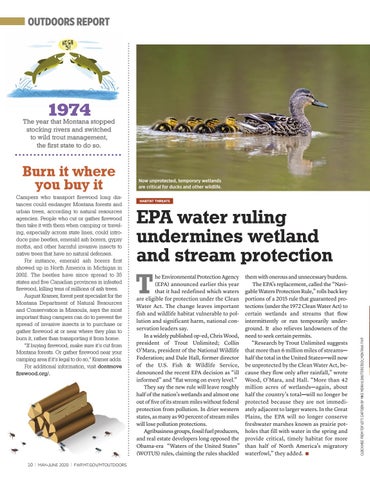OUTDOORS REPORT
1974
The year that Montana stopped stocking rivers and switched to wild trout management, the first state to do so.
Campers who transport firewood long distances could endanger Montana forests and urban trees, according to natural resources agencies. People who cut or gather firewood then take it with them when camping or traveling, especially across state lines, could introduce pine beetles, emerald ash borers, gypsy moths, and other harmful invasive insects to native trees that have no natural defenses. For instance, emerald ash borers first showed up in North America in Michigan in 2002. The beetles have since spread to 35 states and five Canadian provinces in infested firewood, killing tens of millions of ash trees. August Kramer, forest pest specialist for the Montana Department of Natural Resources and Conservation in Missoula, says the most important thing campers can do to prevent the spread of invasive insects is to purchase or gather firewood at or near where they plan to burn it, rather than transporting it from home. “If buying firewood, make sure it’s cut from Montana forests. Or gather firewood near your camping area if it’s legal to do so,” Kramer adds. For additional information, visit dontmove firewood.org/.
10 | MAY–JUNE 2020 | FWP.MT.GOV/MTOUTDOORS
Now unprotected, temporary wetlands are critical for ducks and other wildlife. HABITAT THREATS
EPA water ruling undermines wetland and stream protection
T
he Environmental Protection Agency (EPA) announced earlier this year that it had redefined which waters are eligible for protection under the Clean Water Act. The change leaves important fish and wildlife habitat vulnerable to pollution and significant harm, national conservation leaders say. In a widely published op-ed, Chris Wood, president of Trout Unlimited; Collin O’Mara, president of the National Wildlife Federation; and Dale Hall, former director of the U.S. Fish & Wildlife Service, denounced the recent EPA decision as “ill informed” and “flat wrong on every level.” They say the new rule will leave roughly half of the nation’s wetlands and almost one out of five of its stream miles without federal protection from pollution. In drier western states, as many as 90 percent of stream miles will lose pollution protections. Agribusiness groups, fossil fuel producers, and real estate developers long opposed the Obama-era “Waters of the United States” (WOTUS) rules, claiming the rules shackled
them with onerous and unnecessary burdens. The EPA’s replacement, called the “Navigable Waters Protection Rule,” rolls back key portions of a 2015 rule that guaranteed protections (under the 1972 Clean Water Act) to certain wetlands and streams that flow intermittently or run temporarily underground. It also relieves landowners of the need to seek certain permits. “Research by Trout Unlimited suggests that more than 6 million miles of streams— half the total in the United States—will now be unprotected by the Clean Water Act, because they flow only after rainfall,” wrote Wood, O’Mara, and Hall. “More than 42 million acres of wetlands—again, about half the country’s total—will no longer be protected because they are not immediately adjacent to larger waters. In the Great Plains, the EPA will no longer conserve freshwater marshes known as prairie potholes that fill with water in the spring and provide critical, timely habitat for more than half of North America’s migratory waterfowl,” they added. n
CLOCKWISE FROM TOP LEFT: CARTOON BY MIKE MORAN; SHUTTERSTOCK; MONTANA FWP
Burn it where you buy it








